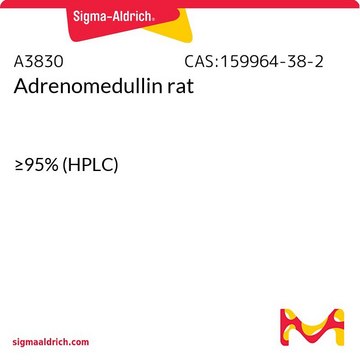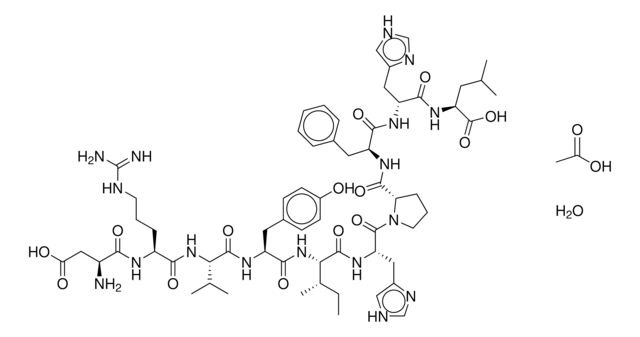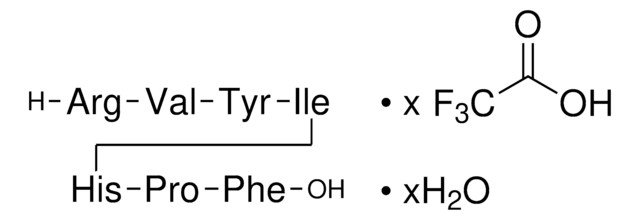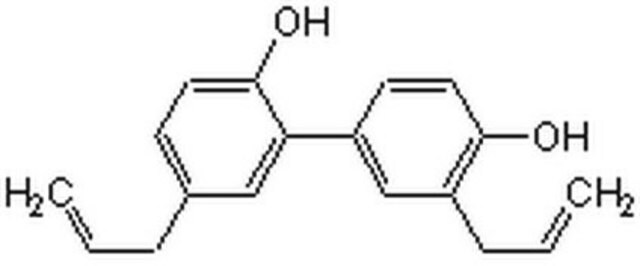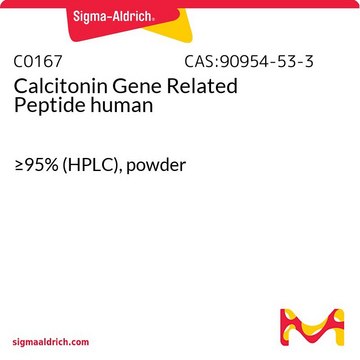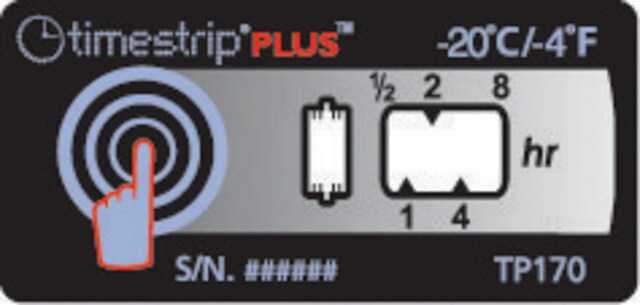A3832
Adrenomedullin Fragment 22-52 human
≥97% (HPLC)
Se connecterpour consulter vos tarifs contractuels et ceux de votre entreprise/organisme
About This Item
Formule empirique (notation de Hill) :
C159H252N46O48
Numéro CAS:
Poids moléculaire :
3575.98
Numéro MDL:
Code UNSPSC :
12352209
Nomenclature NACRES :
NA.26
Produits recommandés
Amino Acid Sequence
Thr-Val-Gln-Lys-Leu-Ala-His-Gln-Ile-Tyr-Gln-Phe-Thr-Asp-Lys-Asp-Lys-Asp-Asn-Val-Ala-Pro-Arg-Ser-Lys-Ile-Ser-Pro-Gln-Gly-Tyr-NH2
Actions biochimiques/physiologiques
Adrenomedullin Fragment 22-52 [ADM22-52] is used as an adrenomedullin (ADM) receptor antagonist to study the functions and mechanism of action of ADM signaling. ADM(22-52) is used to differentiate adrenomedullin binding sites in various cells and tissues.
Code de la classe de stockage
11 - Combustible Solids
Classe de danger pour l'eau (WGK)
WGK 3
Point d'éclair (°F)
Not applicable
Point d'éclair (°C)
Not applicable
Équipement de protection individuelle
Eyeshields, Gloves, type N95 (US)
Faites votre choix parmi les versions les plus récentes :
Déjà en possession de ce produit ?
Retrouvez la documentation relative aux produits que vous avez récemment achetés dans la Bibliothèque de documents.
Agnieszka Ziolkowska et al.
International journal of molecular medicine, 11(5), 613-615 (2003-04-10)
Adrenomedullin (ADM) and its receptors are expressed in the adrenal cortex, where ADM is currently known to inhibit agonist-stimulated aldosterone secretion from zona glomerulosa (ZG), without affecting either basal aldosterone release or the secretory activity of zona fasciculata-reticularis (ZF/R) cells.
Takahisa Ishikawa et al.
Oncogene, 22(8), 1238-1242 (2003-02-28)
Since it is reported that adrenomedullin (AM) upregulated by hypoxia inhibits hypoxic cell death, we examined the effects of AM antagonist (AM C-terminal fragment; AM(22-52)) on the growth of pancreatic cancer cells. We, for the first time, demonstrated that AM
Christian Juaneda et al.
European journal of pharmacology, 474(2-3), 165-174 (2003-08-19)
The existence of specific adrenomedullin receptor binding sites was investigated using the agonist peptide fragment [125I]human adrenomedullin-(13-52) in rat brain, lung and vas deferens homogenates. Saturation-binding experiments suggest that [125I]human adrenomedullin-(13-52) binds to an apparent single population of sites with
Jing Hui Yang et al.
Regulatory peptides, 158(1-3), 19-25 (2009-06-16)
Intermedin (IMD) is a novel peptide related to calcitonin gene-related peptide (CGRP) and adrenomedullin (ADM). Proteolytic processing of a larger precursor of IMD yields a biologically active C-terminal fragment IMD(1-53). We aimed to observe the cardioprotective antifibrotic effects of IMD(1-53)
Benjamin Uzan et al.
Journal of cellular physiology, 215(1), 122-128 (2007-10-18)
Adrenomedullin (ADM) has been shown to mediate multifunctional responses in cell culture and animal system such as regulation of growth and apoptosis. ADM stimulates the proliferation of osteoblasts in vitro and promotes bone growth in vivo. The ability of ADM
Notre équipe de scientifiques dispose d'une expérience dans tous les secteurs de la recherche, notamment en sciences de la vie, science des matériaux, synthèse chimique, chromatographie, analyse et dans de nombreux autres domaines..
Contacter notre Service technique
